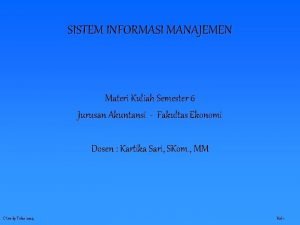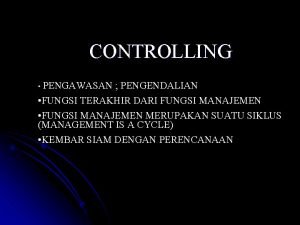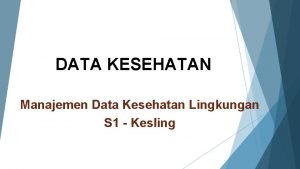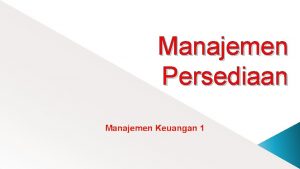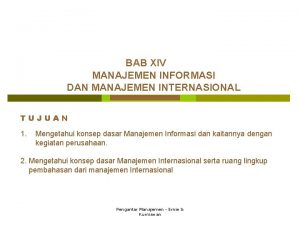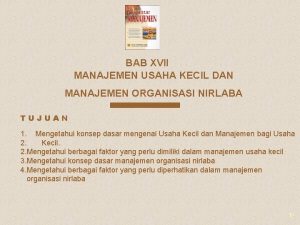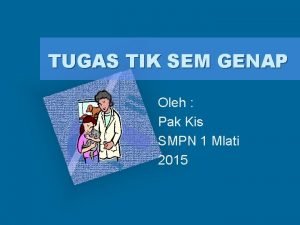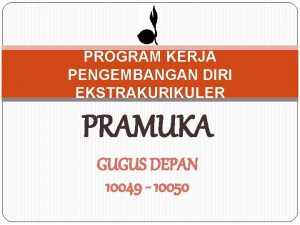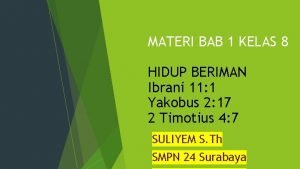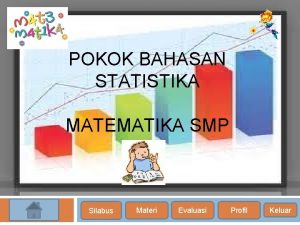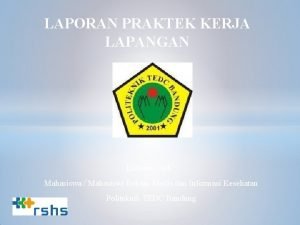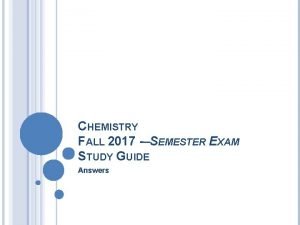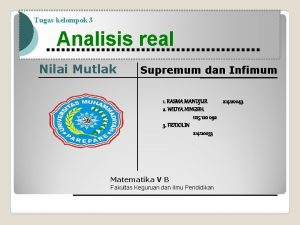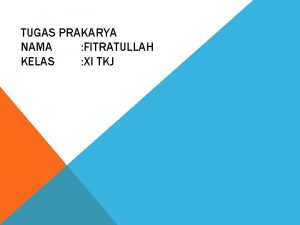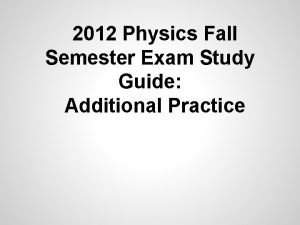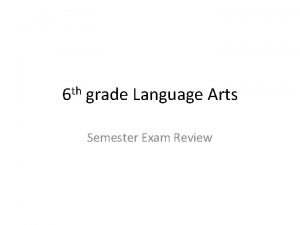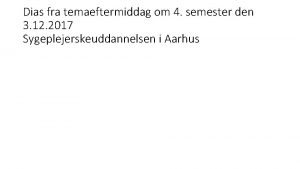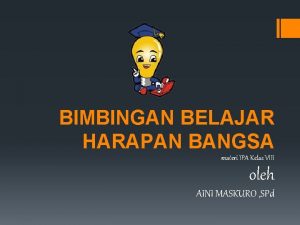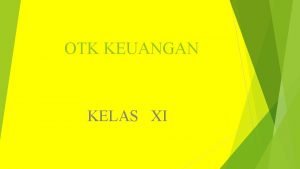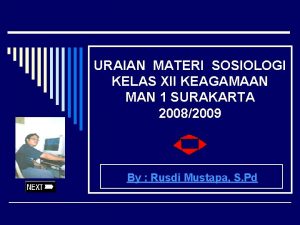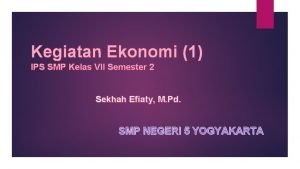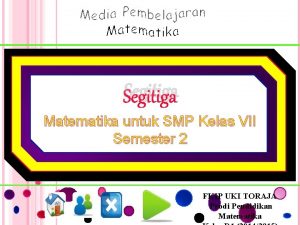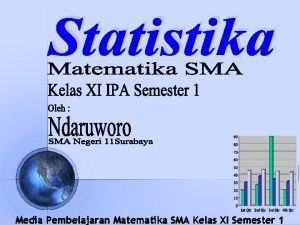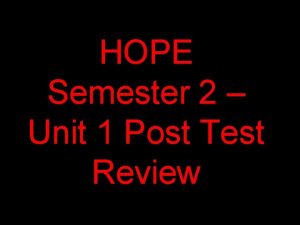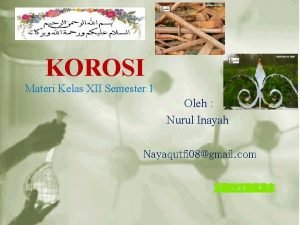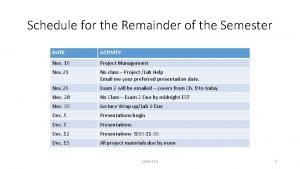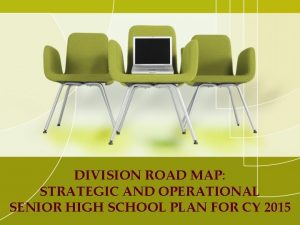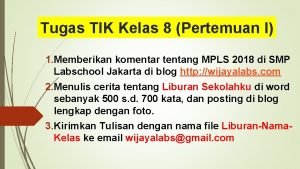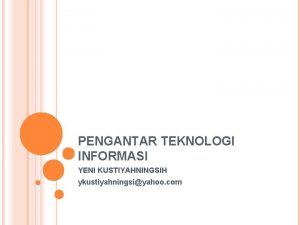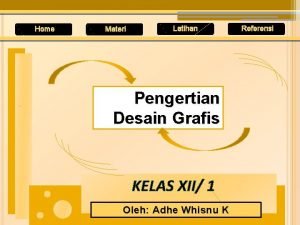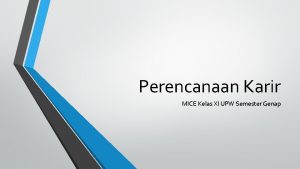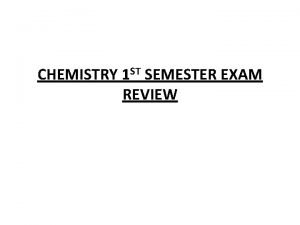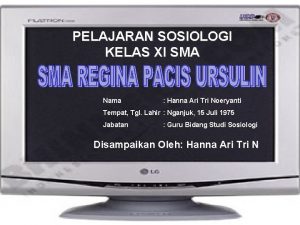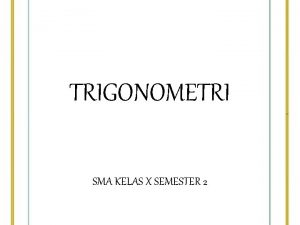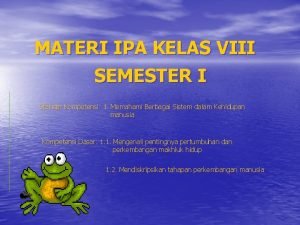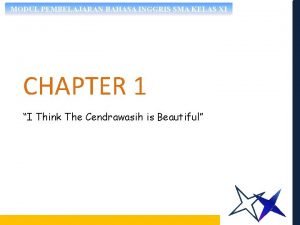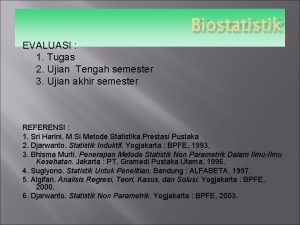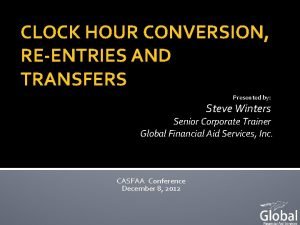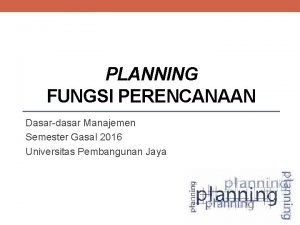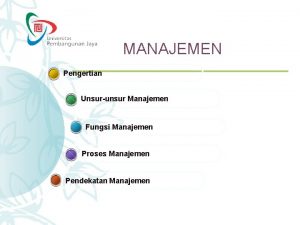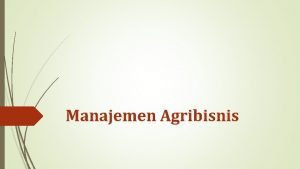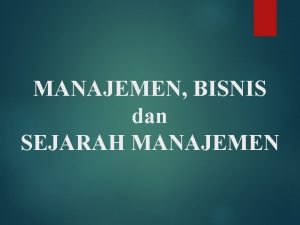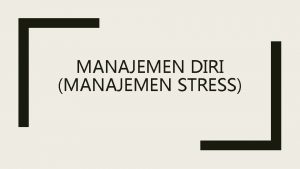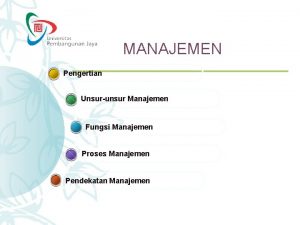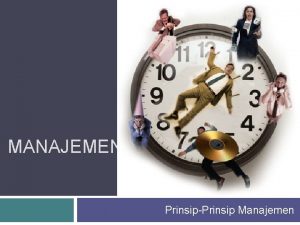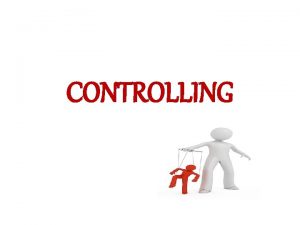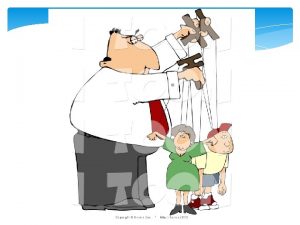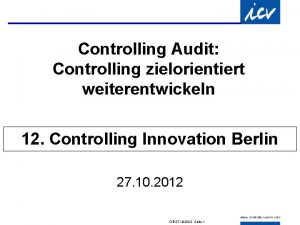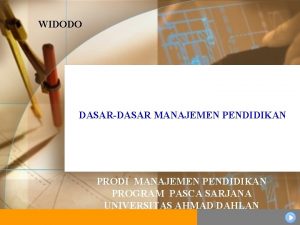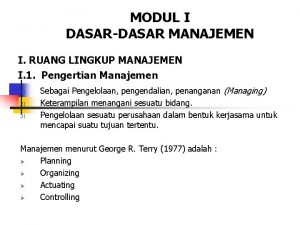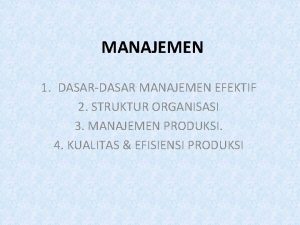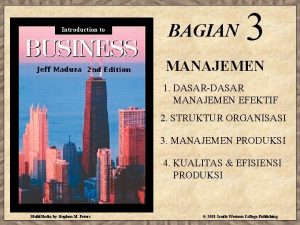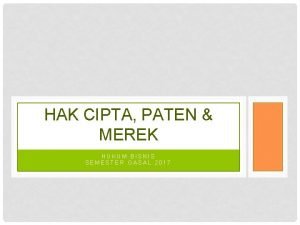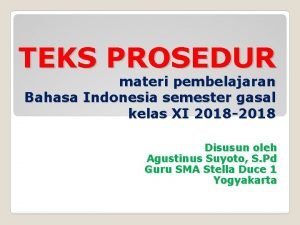Controlling Dasardasar Manajemen Semester Gasal 2016 PengawasanPengendalian Controlling



























































- Slides: 59

Controlling Dasar-dasar Manajemen Semester Gasal 2016

Pengawasan/Pengendalian Controlling Tujuan tercapai Secara effisien dan efektif Pengendalian yang tepat dapat membantu mengetahui area yang perlu diperbaiki

Pengertian Controlling • Proses mengawasi, membandingkan, dan mengoreksi kinerja (Robbins, De. Cenzo & Coulter, 2011) • The process of measuring performance and taking action to ensure desired results (Schemerhorn, 2011)

Pengertian • KOONTZ Adalah pengukuran dan perbaikan terhadap pelaksanaan kinerja, agar rencana yang telah dibuat untuk mencapai tujuan perusahaan dapat terselenggara. • STONER Adalah proses untuk memastikan bahwa segala aktifitas yang terlaksana sesuai dengan apa yang telah direncanakan. 2/25/2021 4

Planning and Controlling berhubungan erat dengan planning karena: • Controlling harus direncanakan • Controlling hanya dapat dilakukan jika ada planning • Implementasi rencana akan baik, jika kontrol dilakukan dengan baik • Evaluasi terhadap efektivitas tujuan dapat dilakukan setelah fungsi kontrol dilakukan 2/25/2021 5

Tujuan. . . • Mengetahui apakah tujuan organisasi yang telah ditetapkan telah tercapai atau jika belum, apakah alasannya • Memberikan critical link terhadap perencanaan • Ensures that the right things happen, in the right way, at the right time • Dapat memberikan informasi dan umpan balik atas kinerja karyawan sehingga meminimalkan timbulnya masalah.

Pengawasan vs Pengendalian Perbedaan mendasar antara pengawasan dan pengendalian adalah • Pengawasan dapat dilakukan secara periodik (berkala) sedangkan • Pengendalian harus dilakukan setiap saat.

Beberapa Gejala yang memerlukan Pengawasan • Terjadi penurunan pendapatan atau profit, namun tidak begitu jelas faktor penyebabnya • Penurunan kualitas pelayanan (teridentifikasi dari adanya keluhan pelanggan) • Ketidakpuasan pegawai (teridentifikasi dari adanya keluhan pegawai, produktifitas kerja yang menurun, dan lain sebagainya) • Berkurangnya kas perusahaan • Banyaknya pegawai atau pekerja yang menganggur • Tidak terorganisasinya setiap pekerjaan dengan baik • Biaya yang melebihi anggaran • Adanya penghamburan dan inefisiensi

Figure 8. 4 Four steps in the control process. Source: Schemerhorn, 2 --9 Management 8/e - Chapter 8 9

Step 1: Setting Standards 1. A good standard must enable goal achievement. 2. Listening to customers or observing competitors. 3. Benchmarking other companies. – – – Determine what to benchmark. Identify the companies against which to benchmark. Collect data to determine other companies’ performance standards. 1. 1 10

Step 2: Measuring: How and What We Measure • Sources of Information (How) • Control Criteria (What) – Personal observation – Employees – Statistical reports • Satisfaction – Oral reports • Turnover – Written reports • Absenteeism – Budgets • Costs • Output © 2007 Prentice Hall, Inc. All rights reserved. 18– 11 • Sales

Step 3: Comparison to Standards 1. Compare actual performance to performance standards. The use of “secret shoppers” helps verify that performance standards are being met. 1. 2 12

Step 4: Corrective Action • Identify performance deviations • Analyze those deviations • Develop and implement programs to correct them Correct 1. 3 Identify Control Process Analyz e 13

Taking Managerial Action • Courses of Action – “Doing nothing” • Only if deviation is judged to be insignificant. – Correcting actual (current) performance • Immediate corrective action to correct the problem at once. • Basic corrective action to locate and to correct the source of the deviation. • Corrective Actions – Change strategy, structure, compensation scheme, or training programs; redesign jobs; or fire employees © 2007 Prentice Hall, Inc. All rights reserved. 18– 14

Taking Managerial Action (cont’d) • Courses of Action (cont’d) – Revising the standard • Examining the standard to ascertain whether or not the standard is realistic, fair, and achievable. – Upholding the validity of the standard. – Resetting goals that were initially set too low or too high. © 2007 Prentice Hall, Inc. All rights reserved. 18– 15

Exhibit 18– 7 © 2007 Prentice Hall, Inc. All rights reserved. Managerial Decisions in the Control Process 18– 16

Tools for Controlling Organizational Performance • Feedforward Control – A control that prevents anticipated problems before actual occurrences of the problem. • Building in quality through design. • Requiring suppliers conform to ISO 9002. • Concurrent Control – A control that takes place while the monitored activity is in progress. • Direct supervision: management by walking around. © 2007 Prentice Hall, Inc. All rights reserved. 18– 17

Exhibit 18– 9 © 2007 Prentice Hall, Inc. All rights reserved. Types of Control 18– 18

Tools for Controlling Organizational Performance (cont’d) • Feedback Control – A control that takes place after an activity is done. • Corrective action is after-the-fact, when the problem has already occurred. – Advantages of feedback controls: • Provide managers with information on the effectiveness of their planning efforts. • Enhance employee motivation by providing them with information on how well they are doing. © 2007 Prentice Hall, Inc. All rights reserved. 18– 19

Levels of Control • Strategic control – monitoring performance to ensure that strategic plans are being implemented and taking corrective action as needed • Tactical control – monitoring performance to ensure that tactical plans - those at the divisional or departmental level - are being implemented 16 -20

Levels of Control • Operational control – monitoring performance to ensure that operational plans - day-to-day goals - are being implemented and taking corrective action as needed © 2016 by Mc. Graw-Hill Education. This is proprietary material solely for authorized instructor use. Not authorized for sale or distribution in any manner. This document may not be copied, scanned, duplicated, forwarded, distributed, or posted on a website, in whole or part. 16 -21

Six Areas of Control Physical Human resources Informational Financial Structural Cultural © 2016 by Mc. Graw-Hill Education. This is proprietary material solely 16 -22

Tools for Controlling Organizational Performance: Financial Controls • Traditional Controls • Other Measures – Ratio analysis – Economic Value Added (EVA) • Liquidity – Market Value Added (MVA) • Leverage • Activity • Profitability – Budget Analysis • Quantitative standards • Deviations © 2007 Prentice Hall, Inc. All rights reserved. 18– 23

Ø Break-even analysis … – Determination of the point at which sales revenues are sufficient to cover costs. – Break-Even Point = Fixed Costs / (Price – Variable Costs) – Used in evaluating: • New products • New program initiatives Management 8/e - Chapter 8 24

Figure 8. 7 Graphical approach to breakeven analysis. Management 8/e - Chapter 8 25

The Balanced Scoreboard • Balanced scoreboard – gives top managers a fast but comprehensive view of the organization via four indicators: (1) customer satisfaction, (2) internal processes, (3) innovation and improvement activities and, (4) financial measures © 2016 by Mc. Graw-Hill Education. This is proprietary material solely 16 -26

The Balanced Scorecard: Four Perspectives Figure 16. 5 © 2016 by Mc. Graw-Hill 16 -27 Education. This is proprietary material solely

The Balanced Scorecard: Four Perspectives • Financial – profitability, growth, shareholder values • Customer – priority is taking care of the customer • Internal business – quality, employee skills, and productivity • Innovation & learning – learning and growth of employees © 2016 by Mc. Graw-Hill Education. This is proprietary material solely 16 -28

Why Measure-Managed Firms Succeed • • Top executives agree on strategy Communication is clear There is better focus and alignment The organizational culture emphasizes teamwork and allows risk taking © 2016 by Mc. Graw-Hill Education. This is proprietary material solely 16 -29

Barriers to Effective Measurement • Objectives are fuzzy • Managers put too much trust in informal feedback systems • Employees resist new measurement systems • Companies focus too much on measuring activities instead of results © 2016 by Mc. Graw-Hill Education. This is proprietary material solely 16 -30

Budgets: Formal Financial Projections • Budget – formal financial projection • Incremental budgeting – allocates increased or decreased funds to a department by using the last budget period as a reference point – only incremental changes in the budget request are reviewed © 2016 by Mc. Graw-Hill Education. This is proprietary material solely 16 -31

Types of Budgets Table 16. 1 © 2016 by Mc. Graw-Hill Education. This is proprietary material solely 16 -32

Fixed versus Variable Budgets • Fixed budgets – allocates resources on the basis of a single estimate of costs • Variable budgets – allows the allocation of resources to vary in proportion with various levels of activity © 2016 by Mc. Graw-Hill Education. This is proprietary material solely 16 -33

Financial Statements • Balanced sheet – summarizes an organization’s overall financial worth – assets and liabilities at a specific point in time • Income statement – summarizes an organization’s financial results – revenues and expenses - over specified period of time © 2016 by Mc. Graw-Hill Education. This is proprietary material solely 16 -34

Ratio Analysis • Liquidity ratios – indicate how easily a firm’s assets can be converted to cash • Debt management ratios – degree to which a firm can meet it’s long-term financial obligations • Return ratios – how effective management is generating a return or profit © 2016 by Mc. Graw-Hill Education. This is proprietary material solely 16 -35

Audits • Audit – formal verification of an organization’s financial and operational systems • External – performed by outside experts • Internal – performed by organization’s own professional staff © 2016 by Mc. Graw-Hill Education. This is proprietary material solely 16 -36

Deming Management 1. Quality should be aimed at the needs of the consumer 2. Companies should aim at improving the system, not blaming workers 3. Improved quality leads to increased market share, increased company prospects, & increased employment 4. Quality can be improved on the basis of hard data, using the PDCA cycle © 2016 by Mc. Graw-Hill Education. This is proprietary material solely 16 -37

The PDCA Cycle Figure 16. 7 © 2016 by Mc. Graw-Hill Education. This is proprietary material solely 16 -38

Total Quality Management • Total Quality Management (TQM) – a comprehensive approach - led by top management and supported throughout the organization - dedicated to continuous quality improvement, training, and customer satisfaction © 2016 by Mc. Graw-Hill Education. This is proprietary material solely 16 -39

Two Core Principles of TQM 1. People orientation – everyone involved in the organization should focus on delivering value to customers 2. Improvement orientation – everyone should work on continuously improving work processes © 2016 by Mc. Graw-Hill Education. This is proprietary material solely 16 -40

People Orientation • Delivering customer value is most important • People will focus on quality if given empowerment • TQM requires training, teamwork, and cross-functional efforts © 2016 by Mc. Graw-Hill Education. This is proprietary material solely 16 -41

Improvement Orientation • It’s less expensive to do it right the first time • It’s better to do small improvements all the time • Accurate standards must be followed to eliminate small variations • There must be strong commitment from top management © 2016 by Mc. Graw-Hill Education. This is proprietary material solely 16 -42

Applying TQM to Services • RATER scale – enables customers to rate the quality of a service along dimensions – reliability, assurance, tangibles, empathy, and responsiveness © 2016 by Mc. Graw-Hill Education. This is proprietary material solely 16 -43

Some TQM Techniques Outsourcing Reduced cycle time ISO 9000 and 14000 Series Statistical process control Six Sigma & Lean Six Sigma © 2016 by Mc. Graw-Hill Education. This is proprietary material solely 16 -44

The Keys to Successful Control Systems 1. They are strategic & results oriented 2. They are timely, accurate, & objective 3. They are realistic, positive, & understandable & encourage self-control 4. They are flexible © 2016 by Mc. Graw-Hill Education. This is proprietary material solely 16 -45

Barriers to Control Success • • • Too much control Too little employee participation Overemphasis on means instead of ends Overemphasis on paperwork Overemphasis on one instead of multiple approaches © 2016 by Mc. Graw-Hill Education. This is proprietary material solely 16 -46

Managing for Productivity • Productivity – outputs divided by inputs where: outputs are the goods and services produced, and inputs are labor, capital, materials, and energy © 2016 by Mc. Graw-Hill Education. This is proprietary material solely 16 -47

Managing for Productivity and Results Figure 16. 8 © 2016 by Mc. Graw-Hill Education. This is proprietary material solely 16 -48

Information Controls • Purposes of Information Controls – As a tool to help managers control other organizational activities. • Managers need the right information at the right time and in the right amount. – As an organizational area that managers need to control. • Managers must have comprehensive and secure controls in place to protect the organization’s important information. © 2007 Prentice Hall, Inc. All rights reserved. 18– 49

What are the common organizational controls? Ø MBO involves a formal agreement specifying … – Workers’ performance objectives for a specific time period. – Plans through which performance objectives will be accomplished. – Standards for measuring accomplishment of performance objectives. – Procedures for reviewing performance results. Management 8/e - Chapter 8 50

Ø The MBO process: – Supervisor and workers jointly set objectives, establish standards, and choose actions. – Workers act individually to perform tasks; supervisors act individually to provide necessary support. – Supervisor and workers jointly review results, discuss implications, and renew the MBO cycle. Management 8/e - Chapter 8 51

Ø Advantages of MBO – Focuses workers on most important tasks and objectives. – Focuses supervisor’s efforts on important areas of support. – Contributes to relationship building. – Gives workers a structured opportunity to participate in decision making. Management 8/e - Chapter 8 52

Ø Employee discipline systems – Discipline is the act of influencing behavior through reprimand. – Discipline that is applied fairly, consistently, and systematically provides useful control. Management 8/e - Chapter 8 53

Ø To be effective, reprimands should … – Be immediate. – Be directed toward actions, not personality. – Be consistently applied. – Be informative. – Occur in a supportive setting. – Support realistic rules. Management 8/e - Chapter 8 54

Ø Purchasing control … – A productivity tool – Trends in purchasing control: • Leveraging buying power • Committing to a small number of suppliers • Working together in supplier-purchaser partnerships Management 8/e - Chapter 8 55

Ø Inventory control – Goal is to ensure that inventory is just the right size to meet performance needs, thus minimizing the cost. – Methods of inventory control: • Economic order quantity • Just-in-time scheduling Management 8/e - Chapter 8 56

Ø Statistical quality control – Quality control involves checking processes, materials, products, and services to ensure that they meet high standards. – Statistical quality control involves: • Taking samples of work. • Measuring quality in the samples. • Determining the acceptability of results. Management 8/e - Chapter 8 57

Keys to Your Managerial Success • • Find your passion and follow it. Encourage self-discovery, and be realistic. Every situation is different, so be flexible Fine-tune your people skills © 2016 by Mc. Graw-Hill Education. This is proprietary material solely 16 -58

Keys to Your Managerial Success • Learn how to develop leadership skills • Treat people as if they matter, because they do • Draw employees and peers into your management process • Be flexible, keep your cool, and take yourself lightly © 2016 by Mc. Graw-Hill Education. This is proprietary material solely 16 -59
 Materi sistem informasi manajemen semester 5
Materi sistem informasi manajemen semester 5 Fungsi manajemen controlling
Fungsi manajemen controlling Fungsi manajemen controlling
Fungsi manajemen controlling Tujuan manajemen data
Tujuan manajemen data Kaitan pengelolaan persediaan dengan manajemen keuangan
Kaitan pengelolaan persediaan dengan manajemen keuangan Manajemen informasi dan manajemen internasional
Manajemen informasi dan manajemen internasional Manajemen usaha kecil dan manajemen organisasi nirlaba
Manajemen usaha kecil dan manajemen organisasi nirlaba Tugas tik kelas 9 semester 2
Tugas tik kelas 9 semester 2 Program kerja ekstrakurikuler pramuka
Program kerja ekstrakurikuler pramuka World history semester 2 final review packet
World history semester 2 final review packet Apes semester 1 final exam
Apes semester 1 final exam Apakah kamu melihat orang tuamu memelihara imannya
Apakah kamu melihat orang tuamu memelihara imannya Modus
Modus Zoology final exam review
Zoology final exam review Contoh laporan pkl di rumah sakit
Contoh laporan pkl di rumah sakit Wharton mbacm
Wharton mbacm Physics semester 1 final exam study guide answers
Physics semester 1 final exam study guide answers Chemistry semester exam study guide
Chemistry semester exam study guide Rubrik penilaian unjuk kerja
Rubrik penilaian unjuk kerja Spanish 1 answer key
Spanish 1 answer key Pengertian supremum dan infimum
Pengertian supremum dan infimum Tugas prakarya kelas 11
Tugas prakarya kelas 11 Physics fall semester exam review
Physics fall semester exam review English 3 fall semester exam review
English 3 fall semester exam review Negara laos beribukota di
Negara laos beribukota di Semester 5
Semester 5 Teoretisk forudsætningskrav eksempel
Teoretisk forudsætningskrav eksempel Rangkuman ipa kelas 8 semester 2
Rangkuman ipa kelas 8 semester 2 Materi keuangan kelas 11
Materi keuangan kelas 11 Materi sosiologi kelas 12 semester 2
Materi sosiologi kelas 12 semester 2 Campus alma mater
Campus alma mater Hamsahamnida
Hamsahamnida Kkm prakarya kelas 9 semester 1 dan 2
Kkm prakarya kelas 9 semester 1 dan 2 Materi segitiga smp kelas 7 semester 2
Materi segitiga smp kelas 7 semester 2 Matematika smk kelas 11 semester 1
Matematika smk kelas 11 semester 1 Materi matematika kelas 11 semester 1
Materi matematika kelas 11 semester 1 Michelle felt an electrical shock when she was ironing
Michelle felt an electrical shock when she was ironing Materi kelas xii semester 1
Materi kelas xii semester 1 For the remainder of the semester
For the remainder of the semester Welcome to 2nd semester
Welcome to 2nd semester Hess strand jobs
Hess strand jobs Algebra 1 semester 2 final exam
Algebra 1 semester 2 final exam B
B Tugas tik kelas 8 semester 2
Tugas tik kelas 8 semester 2 Pengantar teknologi informasi semester 1
Pengantar teknologi informasi semester 1 World history 1st semester midterm exam review answers
World history 1st semester midterm exam review answers World history semester 1 final exam study guide answers
World history semester 1 final exam study guide answers Materi desain grafis kelas 12
Materi desain grafis kelas 12 Materi mice kelas 11 semester 2
Materi mice kelas 11 semester 2 World history semester exam
World history semester exam English 12 semester 1 final exam
English 12 semester 1 final exam Chemistry 1 semester exam review
Chemistry 1 semester exam review English 2 semester exam
English 2 semester exam Peta konsep sosiologi kelas 11 semester 2
Peta konsep sosiologi kelas 11 semester 2 Trigonometri kelas 10 semester 2
Trigonometri kelas 10 semester 2 Kompetensi dasar ipa kelas 8 semester 2
Kompetensi dasar ipa kelas 8 semester 2 Pengantar teknologi informasi semester 1
Pengantar teknologi informasi semester 1 Modul bahasa inggris kelas 11
Modul bahasa inggris kelas 11 Pengertian ujian tengah semester
Pengertian ujian tengah semester Semester vs trimester
Semester vs trimester
